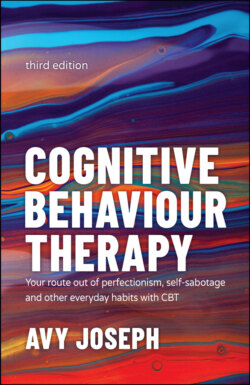Читать книгу Cognitive Behaviour Therapy - Avy Joseph - Страница 24
THEORY MADE SIMPLE
ОглавлениеPutting these principles and philosophies into a theoretical model helps you to see more easily how feelings, different thoughts, behaviours and events all interact with one another.
The easiest is the ‘ABC’ model of emotional response.
A = Activating Event (or trigger)
B = Belief
C = Consequences
The ‘A’ can be:
1 Real or imaginaryThe trigger can be an actual event, such as losing someone or something important to you, or an imaginary one. It could also be an inference – a hunch – like imagining that someone is going to reject you before any rejection has taken place.
2 External or internalExternal events are things that happen outside of your body, for example: someone's death, being rejected, failing at something or experiencing an accident.Internal events are triggers that happen inside your body, for example: your thoughts, images, emotions, fantasies, memories and bodily sensations.
3 About the past, present or futureThe event could be something that has happened in the past, something that is happening now or something that could happen in the future.
Key points to remember:
‘A’ can be an internal past event that was real. For example, losing someone you loved. All past events are internal because they exist in our memories.
‘A’ can be real, future and external. For example, making a speech at your friend's wedding next week.
It is not the event itself that provokes your emotions but what you tell yourself or what you infer about it now that provokes your feeling.
It's easy to assume that A causes C but that would not be accurate.
When a trigger happens at ‘A’, you feel, behave, think and experience symptoms. Because this happens quickly, you think ‘A’ causes ‘C’ (the consequences). So you may use expressions like ‘he made me feel angry’, or ‘my job makes me depressed’. It is as if we are not responsible for our own emotions.
Remember the 100 and 1000 people example earlier?
What is at the heart of your feelings is the ‘B’ (Belief) between ‘A’ and ‘C’. So it is your belief (evaluation) about the activating event that provokes your emotions, thoughts, action tendencies, behaviours and symptoms.
